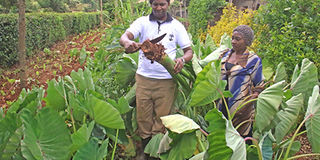Why not farm sweet arrowroots on your kitchen garden?

Dominous Ndegwa harvests an arrowroot in his home's kitchen garden in Nyeri. He notes that the advantage with this type of farming is that one does not have to weed the garden because of the plastic mulch. PHOTO | JOSEPH KANYI | NATION MEDIA GROUP
What you need to know:
- Ndegwa farms a giant variety from Rwanda using rainwater that he collects.
- He uses the upland arrowroot (nduma) technology, with the farm hosting some 500 plants, which he harvests every six months.
- The plant should be inserted in the soil up to a depth of 20cm and the spacing between beds should be 0.5m.
- After three days, he starts to water the crops using drip irrigation, having harvested rain water and stored it in a tank.
The lack of a swamp or river valley on his farm in Nyeri has not stopped Dominous Ndegwa, a farmer in Kangudu-ini village, from growing arrowroots on his kitchen garden.
Ndegwa farms a giant variety from Rwanda using rainwater that he collects. He uses the upland arrowroot (nduma) technology, with the farm hosting some 500 plants, which he harvests every six months.
When he was starting the project, Ndegwa says he did not incur any costs since he got the planting materials from a welfare group donated to them by the county government. To grow the crop, he first digs trenches while separating the top soil from sub soil.
Thereafter, in a ratio of 1:2, he mixes humus with topsoil before returning it into the trench to cover a foot. “One must avoid using a lot of humus to stop the plant from producing more suckers than tubers,” he says.
Thereafter, he drenches the trench with water and then plants the suckers inside with a spacing of 30cm from one plant to another.
The plant should be inserted in the soil up to a depth of 20cm and the spacing between beds should be 0.5m.
He then mulches the crops using a plastic sheet, but one can also put the polythene material inside the trenches.
After three days, he starts to water the crops using drip irrigation, having harvested rain water and stored it in a tank.
REQUIRES PRECAUTIONS
“The advantage of this type of farming is that you don’t have to weed because of the plastic mulch.”
With two harvesting seasons every year, Mr Ndegwa sells the tubers from Sh50 to Sh100 each, depending on the size.
“An arrowroot that goes for Sh50 on the farm has a market value of Sh100. I sell the tubers to traders who operate in different markets in Nyeri.” During dry spells, he is forced to hire people to fetch water from the river.
“I don’t rely on tap water since its chlorinated and will damage the plants. The workers help me pump water from the river, pushing up my costs.”
John Wambugu, an agronomist at Wambugu Farm in Nyeri, says most people in the area have adopted the technology because of moist soils.
“Apart from farmers who live in the drier parts of Mt Kenya, most farmers in the region who have adopted the upland technology prefer collecting rain water to relying on borehole water because the area has generally a cool climate,” the agronomist said.
He added that the Eddoe and Giant Rwanda varieties have become popular among farmers who practice this type of farming.
According to him, however, the technology requires a lot of precautions as one should not apply water used at home on the plants. “Soapy water should not be used on the plants as it would damage the quality.”





